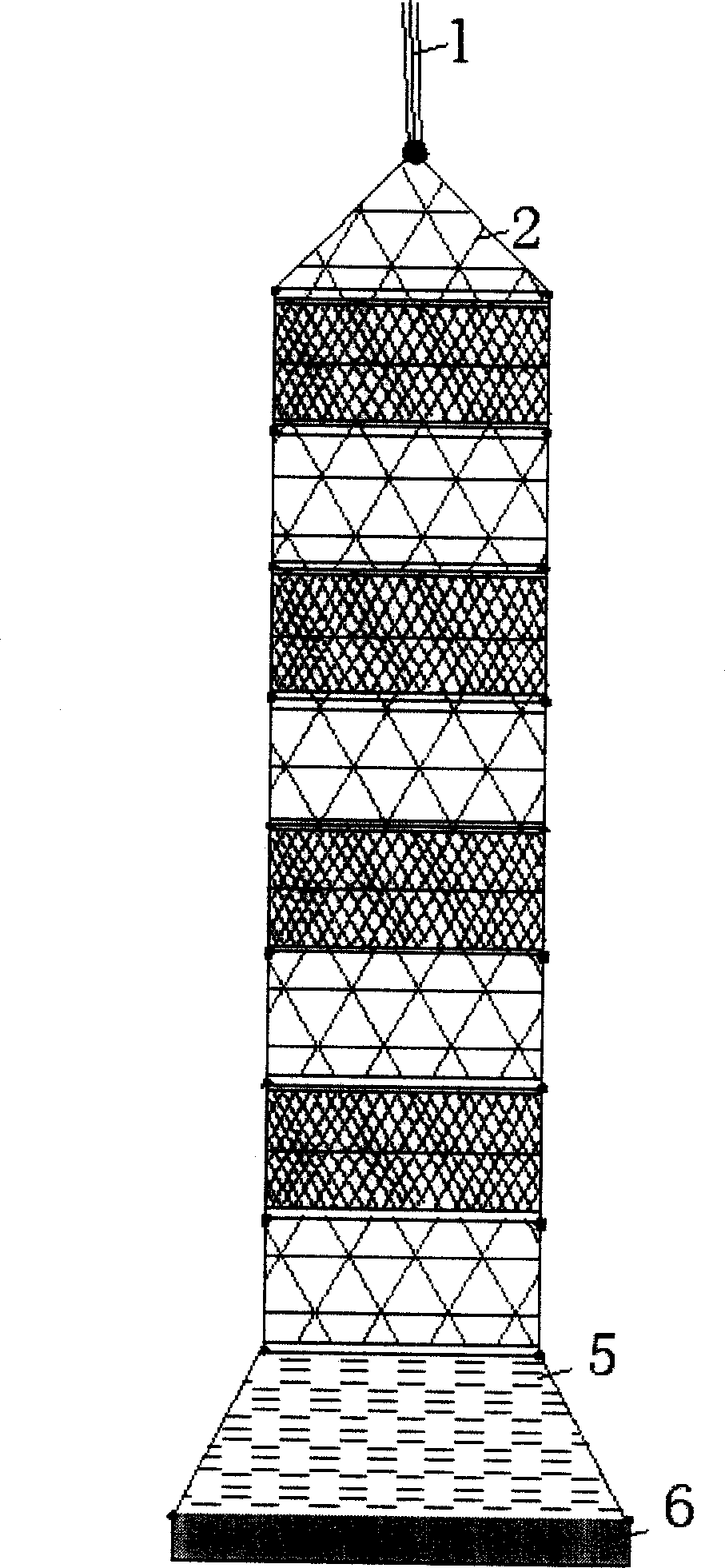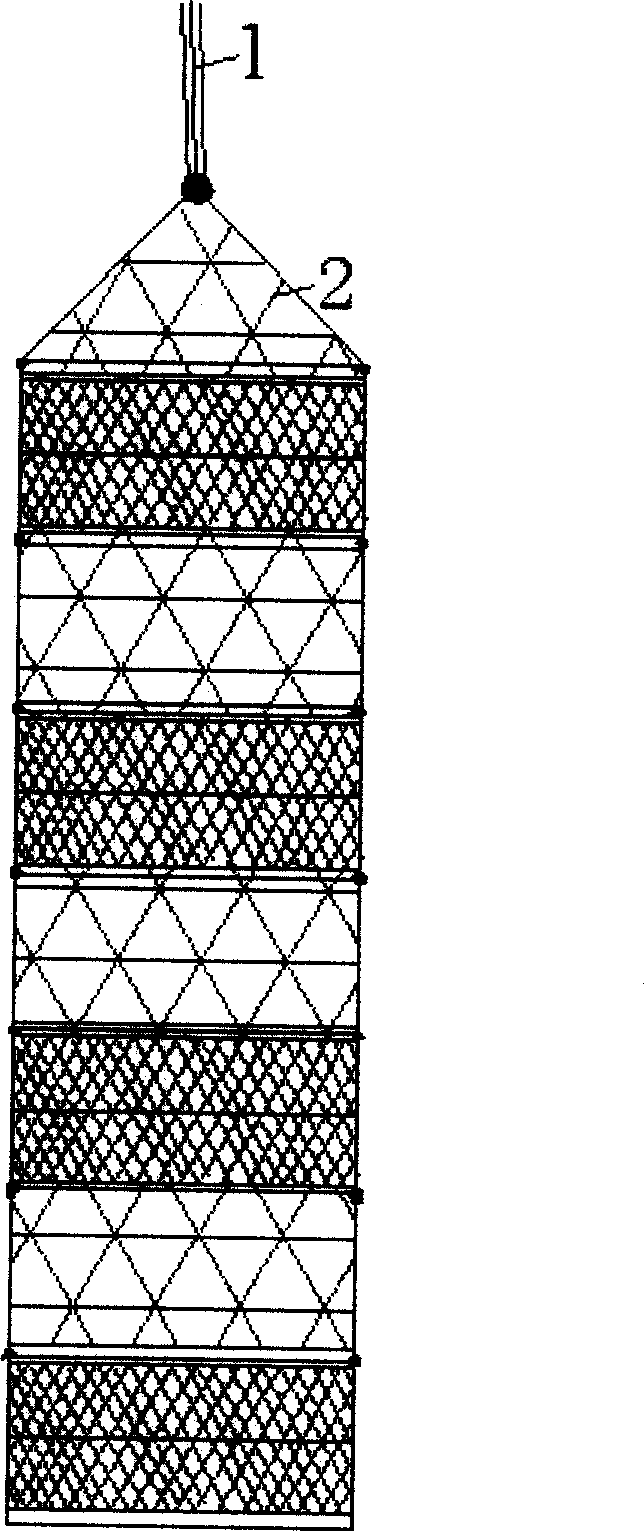A shallow sea seashell breeding method and apparatus with reuse of feces
A breeding method and technology of feces, applied in the field of aquaculture, can solve the problems of not being fully reused, and achieve the effects of slowing down the occurrence of breeding biological diseases, good ecological environment, and slowing down biological sedimentation
- Summary
- Abstract
- Description
- Claims
- Application Information
AI Technical Summary
Problems solved by technology
Method used
Image
Examples
Embodiment 1
[0018] like figure 1 As shown, on the basis of the raft culture cage of Chlamys farreri, a large circular chassis is added at the bottom of the cage. The chassis is made of plastic and has a larger diameter than the culture cage. There is a net between the chassis and the bottom of the cage. The breeding cavity enclosed by shape (made of plastic, mesh smaller than the size of sediment-eating animals) is used to place the cultured sediment-eating animal sea cucumbers such as japonicus. Chlamys farreri is usually cultured about 40 per layer, and 2 to 10 sea cucumbers are stocked in the chassis (6 sea cucumbers are stocked in this embodiment).
[0019] In the figure: 1 is a polyethylene material sling, 2 is a polyethylene material cage, 3 is a supporting plate for aquatic organism breeding, 4 is a polyethylene material fixing rope, 5 is a polyethylene material cage at the bottom, and 6 is a breeding chassis .
[0020] By adopting the polyculture mode and device of the present i...
Embodiment 2
[0024] The difference from Example 1 is:
[0025] like figure 2 As shown, in the present embodiment, sea cucumbers are stocked in the chassis, and every other layer of supporting plates 3, the cage 2 of the culture cage is set up with a dense net, and the sea cucumber is cultivated in the layer where the dense net is located and the layer where the chassis is located, and the food biodeposits The purpose of setting up the dense net is to ensure that a considerable part of the feces of shellfish remains in the cage when the seawater velocity is high, so as to reserve sufficient bait for sea cucumbers. The mesh of present embodiment is 5 millimeters (can adopt the simple mode that the net cage is wrapped up with dense net every other layer), 40 clam scallops are cultivated in every layer, 4 sea cucumbers are stocked in the dense net layer, and the chassis 5 are stocked inside, and the culture guides of Chlamys farreri and sea cucumber culture layers are arranged alternately. ...
Embodiment 3
[0028] The difference from Example 1 is:
[0029] like image 3 As shown, in the present embodiment, every other layer of supporting plate 3, the net cage 2 of culture cage is established dense net, cultivates japonicus in it, ingests biological deposits; When it is used, it can ensure that a considerable part of the excrement of the shellfish remains in the cage, so as to reserve sufficient bait for the sea cucumber. The present embodiment mesh is 5 millimeters, and 40 clam scallops are cultivated in every layer, and 4 sea cucumbers are stocked in the dense mesh layer, and the clam scallop culture layer and the sea cucumber culture layer are arranged alternately. Its output value doubled.
PUM
 Login to View More
Login to View More Abstract
Description
Claims
Application Information
 Login to View More
Login to View More - R&D
- Intellectual Property
- Life Sciences
- Materials
- Tech Scout
- Unparalleled Data Quality
- Higher Quality Content
- 60% Fewer Hallucinations
Browse by: Latest US Patents, China's latest patents, Technical Efficacy Thesaurus, Application Domain, Technology Topic, Popular Technical Reports.
© 2025 PatSnap. All rights reserved.Legal|Privacy policy|Modern Slavery Act Transparency Statement|Sitemap|About US| Contact US: help@patsnap.com



